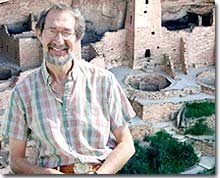Geoffrey West

Geoffrey West at Mesa Verd
Like many people, Geoffrey West had difficulty with his high school physics classes. He did well, but “had problems reckoning the fact that everything could be described by mathematics. It was a great mystery to me at that time that you should actually take these equations seriously, that it wasn’t just a game.”
West, now 62, was born in a rural town in western England and moved to London when he was 13.
“It wouldn’t be much of an exaggeration to say my mother could barely read or write. She left school at 13.” His father left school at 15 and was a professional gambler. “It sounds pretty wild, I know,” West said. “It’s not an intellectual background of the usual kind.”
West went on to Cambridge, where he was initially a math major. He switched to physics when he realized that, “even though mathematics was the language of physics, I was very frustrated by abstraction. I really wanted to understand how things worked and what were the secrets of the universe.”
So he switched over to physics, and even though he found it more satisfying than math had been, he still wasn’t happy.
“I didn’t particularly enjoy most of the courses, and I didn’t do particularly well. I decided that maybe I’d made a mistake in thinking that this was what I wanted to do.”
While he was struggling with his physics classes, he’d met some Americans and become intrigued by the idea of California. He applied to graduate school at Stanford, where he planned to study theoretical physics for a year or two and then return to England, switch to studying English, and become a writer.
“Graduate school at Stanford was really just a ruse to go to California. I had every intention of getting out of physics. But what happened was that when I got there, I found I really enjoyed the other grad students and really enjoyed one or two of the courses. I started to do extremely well and was quite surprised, so I just stayed on.”
After graduating and traveling the post-doctoral circuit for a few years, West, a theoretical particle physicist, eventually ended up back at Stanford as faculty. He left to become the leader of the particle theory group at Los Alamos National Laboratory, in New Mexico.
Although he is currently still at Los Alamos, his focus has shifted from particle to biological physics. He says it happened in the mid-1990s, as an outgrowth of the demise of the Superconducting Super Collider, an enormous accelerator facility that was to be built in Texas.
“When the SSC was torpedoed, probably for purely political reasons, it was partly because of the rising tide of anti-science polemics, especially anti-high-energy-physics polemics. One of the things we used to hear, particularly at Los Alamos, was that physics was the science of the nineteenth and twentieth centuries, and that the science of the twenty-first century would be biology. The corollary was that physics was finished. It was so superficial and so manifestly stupid. I couldn’t believe that supposedly intelligent people who would be making decisions would be mouthing such things.”
Partly because of his anger, West started thinking about biology.
“The problem that got me thinking was an issue that started to raise itself in my personal life,” West said. “It was the obvious fact that I was ageing and dying. I took the biological question—why is it that we die?—and put it into physics terms by asking it a slightly different way: What sets the scale of human lifetime at 100 years?
“Instead of vaguely saying, ‘Oh, it’s genetics,’ I ask the question: Where is 100 years? Can I calculate it from fundamentals? It’s an order of magnitude question, and in trying to understand that, I started to think about biological questions and collaborating with biologists.”
That’s not the normal practice in the physics world, but West thinks that this may be changing.
“This confluence between biology and physics is going to take place,” he said. “The question is, will physicists and physics departments play any role in this? Many departments are still very conservative and very suspicious and ask silly questions like, ‘Is it really physics?’ The question they should be asking is, ‘Is it good science?’”
West and his biologist collaborators at the Santa Fe Institute think it is, and they have written two books on a phenomenon known as biological scaling. It is widely known that there are mathematical relationships between the size of an organism and some of its body mechanisms, such as the speed at which its heart beats or with which it consumes energy.
These relationships are quite remarkably precise; for example, the metabolic rate of an animal is proportional to its mass raised to the three-quarters power. This is just one of many scaling relationships that involve one- or three-quarters power laws, and it holds true from the smallest microorganism to the largest mammal on earth.
West and his colleagues have come up with a mathematical formula to explain this, and West hopes there will eventually be a formula to quantify evolution itself.
“Life is the most complex of all systems,” he said. “Could there be anything more fundamental than trying to understand life? How can physicists not be passionate about this? It’s surely as fundamental to us as the evolution of the universe. What about the origin of consciousness? It’s presumably not something that lies outside the laws of physics. It’s a big soup, but ultimately, these are questions that physics needs to address—and will address.”











